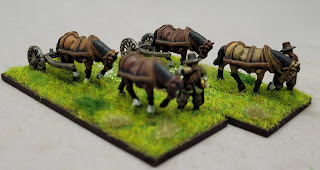So You Want to Know About Royalist Armies?
Finally! I hear some of you say. A Royalist Army reading list.
Well, there's a problem. The Royalist Armies are nowhere near as well documented as the various Parliamentarian Armies.
Why is this the case? There are, potentially, several reasons. Parliament, at every level, consisted of committees who needed minutes, account books and audit trails. Parliament 'won' the Wars, so these records were transferred to what would eventually become The National Archives as State Papers.
The records of the various Royalist Armies don't generally exist in The National Archives. Records tend to exist in the archives of the families of Royalist supporters, and are usually specific to the units that the family raised and equipped.
There may well be 'unknown' military records waiting to be discovered, but these records are not centrally held, and in many cases access is difficult or completely off limits.
Any researcher wanting to collate an "Old Robin's Foot" type volume for the Oxford Army will have a long and arduous task negotiating access, and visiting many houses in an attempt to collate the information, rather than just booking a table at The National Archive in Kew for several weeks/months.
I am reliably informed that an Oxford Army volume is in the pipeline, but I don't think we should hold our breath for a publication date for a while yet.
Throw into the mix Royalist baggage trains having a propensity to being captured (Rupert's at Birmingham, the King's at Naseby) and it is quite likely that some records were lost in the process.
Plus of course the King 'lost', his supporters' houses were, in many cases, stripped of their contents which were either sold, or simply looted. We will never know what evidence or accounts were lost because of this.
There are some good works out there, but none of them are at the same level as "Old Robin's Foot" or "More Like Lions", for the reasons stated above.
With the 'doom and gloom' out of the way, what does exist?
A really good starting point is the 'Indigent Officers' lists, or more correctly 'A List of Officers Claiming to the Sixty Thousand Pounds&c. Granted by His Sacred Majesty for the Relief of His True-Loyal and Indigent Part'. These were lists of officers who fought for the King's cause, and claimed financial recompense from the Restored monarchy for their service.
Thankfully Stuart Reid has put in the hard work, originally with "Officers and Regiments of the Royalist Army" (Partizan Press). This was a series of five pamphlets that have been seriously beefed up and reissued as "The Cavalier Army List" (Partizan Press). This three volume set (volumes 1 & 2 are hardback and contain the lists, volume 3 is the softback index), merges 'Indigent Officers' with the 'Royal Martyrs' lists - unsurprisingly a list of Royalist officers who fell in battle.
These do not just list every officer who served. Opening volume 1 at random I come across the entry for Cary, Sir Horatio. The briefest of biographies is followed by a list of his the officers of his regiment of horse; their rank, where known which troop they served in, and the reference for their inclusion. Other regiments have copious notes. If you are a Facebook user there is a group called The Cavalier Army - Royalist Officers and Regiments of the English Civil War. This is a group that is effectively updating the information in the books, as new research comes to light.
And yes, you really do need to purchase the index (volume 3); makes the whole thing much more user friendly and accessible. This is about as close as you'll currently get to a Royalist "Old Robin's Foot". I heartily recommend the set.
We now turn our attention to Helion's Century of the Soldier series.
"A Rabble of Gentility" (Helion) by John Barratt focuses upon the Royalist Northern Horse who escaped from Marston Moor, forming a mobile fighting force under Sir Marmaduke Langdale. The bulk of the book is a narrative, with an appendix covering 'the men of the Northern Horse'.
If you are interested in Sir Jacob Astley's Army that met its end at Stow-on-the Wold you should look out for John Barratt's "The Last Army" (Helion). The volume mostly focuses upon how the army came into being, and why it was marching south before taking a stand at Stow.
 |
 |
 |
 |
Not quite the three posts that the Parliamentarian's got, but almost certainly a lot more than the Irish Confederates and Montrose's Royalist Army will get.
Suppliers:
Helion
Partizan Press available from Caliver Books
Please note, whilst I do occasionally get sent books to review, I bought all of the above volumes with my own money. Nor do I get any commission for recommending any reading materials...













Comments
Post a Comment